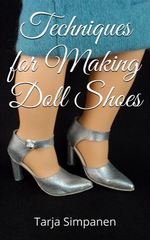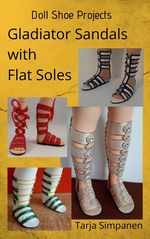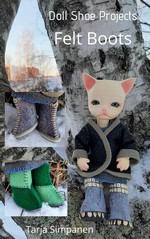This is one of the projects that have remained unfinished for a long time. The idea with these was to create resin soles that would require little additional work for finishing. Of course that didn't turn out to be true, because the painting alone took a lot of effort as these had to painted a bit at the time and using several coats.
The first thing I did was creating a universal sole (same for both left and right) using modeling clay. In this sole, there are holes on the sides for attaching the strap that goes over the toe part. For making the latex mold, the holes are not punched through, but just depressions in the modeling clay to make it easier to drill holes in the resin soles after casting.
In the picture above, the sole is attached to a piece of cardboard with double-sided tape for making a mold. A made two molds (below) to be able to cast a pair at the same time.
Latex molds aren't the best for resin casting, but I managed to cast several pairs using these molds. Below are two of those, and you can see on the leftmost sole that the holes on the side have been drilled through. In the master, I also made a depression for drilling a hole for the heel. In the rightmost sole, you can see a hole drilled there.
The next step was painting. I used enamel paints as they work best with resin. First I painted the inside with a light color as it will touch the doll's foot and I wanted to prevent any staining. I guess I could have left the inside unpainted as the resin is so light colored, but I thought painted inside looked neater. Then I painted the outside edges. I wanted to make sure I wouldn't smudge them, so I painted the outside in two parts to be able to let this first stage dry so that there was no risk of anything touching the paint.
Then I painted the undersides. I don't remember how many coats this needed, but I think it was at least three. With resin, the first coat is always a primer, because there is no way to get it to be even. Once you have one coat of paint, the next coats will stick much better and spread more evenly.
After all sides of the resin had been painted, I attached round wooden sticks as stiletto heels and painted them.
The strap going over the toe part is made of silver-colored plastic, and I used silver-colored thread to attach it in place.
Here is one finished shoe. I have that plastic also in black and silver (I used that for Sybarite's shoes earlier), but that didn't look good with red. I think I might make another pair with that and soles painted with black and silver.
Finally, here are the shoes on Monster High Gooliope Jellington. They aren't a great fit, but they still look nice.






































